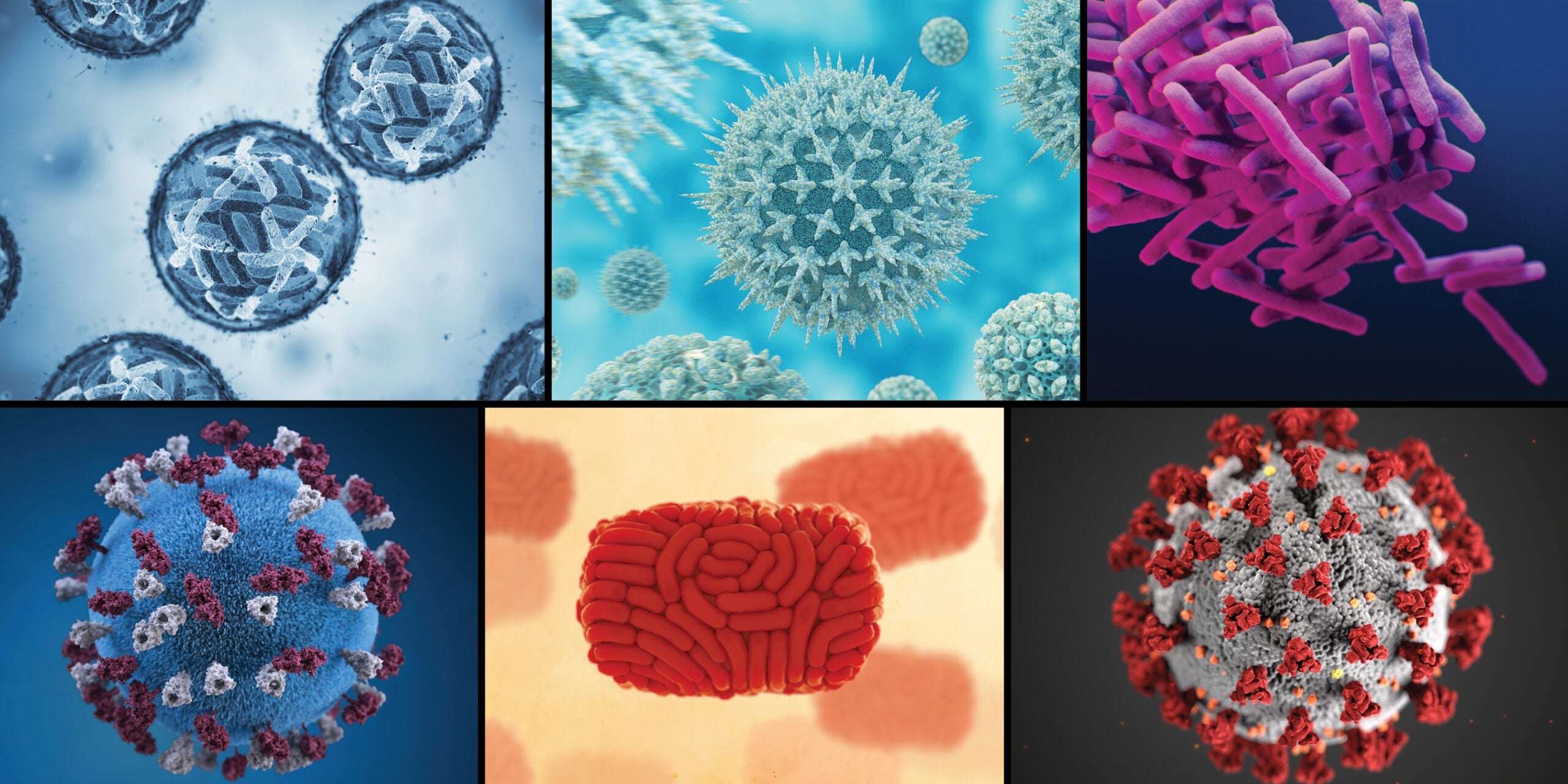The next pandemic: not if, but when

September 12, 2024 – As new cases of bird flu and other infectious diseases continue to raise concern, Harvard T.H. Chan School of Public Health researchers share their perspectives on recognizing, preparing for, and managing future outbreaks.
More than four years ago, the SARS-CoV-2 virus began blazing its trail across a world that was starkly unprepared for what lay ahead. As of August 2024, the virus had infected more than 700 million people and caused more than 7 million deaths. The pandemic also shined a light on vast health inequities, led to economic disruption, and spawned vitriolic politics on everything from masks to vaccines to school closures.
In recent months, with COVID-19 receding for many into less of an existential threat and more of an accepted undercurrent to daily life, a new infectious disease outbreak—H5N1 avian flu virus, or bird flu—started making headlines as it spread among dairy cows and poultry in the U.S. and infected a small number of farmworkers. Against this backdrop, we asked five Harvard Chan School researchers to weigh in on what we learned (or didn’t learn) from the COVID pandemic, what their main worries are regarding current and future infectious disease risks, and what steps we should be taking to minimize risks going forward.
Experts quoted include:
-
- Joe Allen, associate professor of exposure assessment science and director of the Healthy Buildings program
-
- Caroline Buckee, professor of epidemiology and associate director of the Center for Communicable Disease Dynamics (CCDD)
-
- Sarah Fortune, John LaPorte Given Professor of Immunology and Infectious Diseases and chair of the Department of Immunology and Infectious Diseases
-
- Yonatan Grad, professor of immunology and infectious diseases
-
- Bill Hanage, associate professor of epidemiology and CCDD associate director

Q: What have we learned about managing a runaway infectious disease outbreak?
Caroline Buckee: One of the confirmatory lessons for me—it’s not a new lesson—was that governments and people are reactive. And it’s very hard to get significant investment in preparedness.
When it comes to pandemics, or epidemics in general, one of the hardest things about preparedness is that if you’re doing it really well, no outbreak—or only a small outbreak—occurs. Proving that you have averted an epidemic is difficult, so politically, how do you justify the investment required? It’s a really hard problem.
Joe Allen: One lesson learned is the importance of our buildings in disease spread. The way we design and operate our buildings can limit transmission. People in my field were talking about this early in the pandemic, but it took us at least a year to get the CDC [Centers for Disease Control and Prevention], WHO [World Health Organization], and others to recognize that airborne transmission was the primary driver of COVID infections. I’m optimistic that we will never forget that lesson—that respiratory pathogens are spread from person to person nearly entirely indoors, which means that making our buildings safer should be part of the frontline defense in pandemic response.
Bill Hanage: We’ve learned that it’s a marathon, not a sprint, and the importance of vaccinating people.
Q: Is another pandemic inevitable? And if so, what are your main concerns about how the U.S. and the world will respond?

Yonatan Grad: Is there another pandemic coming? Yes. When? Which pathogen? How severe will it be? No one can say for sure. But the big demographic changes that are coming, due to climate change as well as economic and other factors, will alter the landscape and create new risks, both for new pathogens to emerge and for known pathogens to re-emerge.
A remarkable accomplishment during the COVID pandemic was how quickly the scientific community responded to a new pathogen, from sequencing its genome to development of a vaccine. That provides a measure of hope—modulated by concerns about providing the needed funding for infectious disease researchers and public health efforts. As long as we invest in basic research and translational research and in public health, we will be in a position to respond as quickly as possible.

Sarah Fortune: To me the question is not whether there’s going to be another pandemic—clearly there’s risk of another—but this: What are we going to do about the constant drumbeat of infectious diseases that’s already playing out both domestically and globally? I work on tuberculosis [TB], which is the leading cause of infectious disease deaths. The focus on the next pandemic ignores the fact that, right now, children are dying of TB, malaria, diarrheal diseases, pneumonia. And these are by and large diseases that we as a society—if all the pieces were in place—would totally be able to control and abrogate their death toll.
Buckee: Another pandemic will happen. It’s just a matter of time.
As for what we learned from the COVID pandemic, on the positive side, in some ways it’s much easier to invest in and accelerate technological change, like wastewater surveillance technologies and mRNA vaccines. In that sense, I think we’re in a better place now than we were before COVID.
Also, we now have sophisticated computational techniques and modeling frameworks, as well as new data streams from things like mobile phones and wastewater genomic data. We have the sort of technical and analytic expertise that will be important in responding effectively to future outbreaks. For example, the CDC’s Center for Forecasting and Outbreak Analytics [where Marc Lipsitch, professor of epidemiology and Center for Communicable Disease Dynamics (CCDD) director, is serving as senior advisor] is attempting to bring some of the sophisticated modeling and data to support public health at the state and local level. I think that effort is great. A lot of our CCDD alums have gone on to work there.
On the negative side, I think we haven’t learned the lesson that massively complex epidemiological models using “big data” are not particularly helpful for communities trying to deal with local outbreaks. In 2020, I worked with Satchit Balsari at Harvard Chan School and Andrew Schroeder at Direct Relief to start the COVID-19 Mobility Data Network, aimed at helping decision-makers at the state and local level understand what datasets mean—for example, helping them monitor lockdown behavior or figure out where to put mobile vaccination units. I believe that we need models that incorporate locally contextualized data—because public health is a local issue.
I also think that we have failed to address, and are continuing to fail to address, the social aspects of a public health response to epidemics—the huge global inequalities in things like vaccine allocation. Vulnerable and minority populations were disproportionately affected [by COVID] simply because of the social and economic hierarchies that we’ve put in place. And those hierarchies remain.

Allen: In the early days of the pandemic, there was a lot of confusion and delay over things like masking, rapid tests, and ventilation in buildings. It took us about a year, for example, to authorize rapid tests. Now we’re past that—people are used to these tests. The government started giving these away, and you can go to your local pharmacy now and buy them. As for masks, there was debate at the beginning about whether they work. Of course they work. The evidence is really clear. My sense is that, in the next pandemic, that in the period as we wait for rapid development of a vaccine, we will more quickly deploy the tools at our disposal, including masks, tests, and better ventilation and filtration. We won’t have to wait a year again to convince people that all of this matters.
Q: Do you think that COVID fatigue will hamper our collective response to the next big infectious disease threat?

Hanage: I do think that COVID fatigue will hamper our response—100 percent. But the key is to invest in preparedness to make pandemic management more sustainable—everything from better ventilation, to funding for soap in public school bathrooms, to having studies ready to go in order to determine the most effective interventions.
Buckee: People do have COVID fatigue—both funding fatigue and societal fatigue. This was hard on people.
If there was another pandemic, I can’t imagine a particularly different trajectory. I don’t think we’ve built trust in government among communities. I don’t think that there’s been significant improvements to how our political process would work in the event of another public health emergency—despite the fact that [responding to a pandemic] should be completely bipartisan. It’s not a political issue; it’s an existential threat to our society.
Allen: People have been through a lot over the last few years. It’s understandable they are ready to move on as the COVID threat recedes. But I also think that, in the face of a new threat, people will react rationally for the most part and will ramp up protections. If hospitals begin to fill up, I think that’s going to change behavior real fast.
Q: In the last few months, cases of infectious diseases such as mpox, dengue, and measles have popped up around the U.S. Which of these diseases worries you most right now? What about over the next couple of years?
Grad: One major concern is the drop in vaccination rates in some parts of the country and the world. This has already led to an increase in vaccine-preventable diseases. For example, there have been outbreaks of measles globally, in part because of the anti-vax movement and in part due to the challenges in vaccinating pediatric populations during the pandemic. And there have been cases of polio and outbreaks of diphtheria—both diseases for which there are highly effective vaccines.
Another concern is related to the spread of vectors and the diseases they carry. Cases of dengue in Los Angeles and in Maricopa County, Arizona, in individuals with no history of travel raise concern that there may be endemic circulation of that disease. To what extent that’s true and how much that’s going to persist season after season, we’re going to find out—but the expectation should be that we will see more of this. Cases of locally acquired malaria in Maryland, Florida, and Texas raise concern about the spread of these mosquito-borne diseases.
A third concern is the persistent and recalcitrant problem of antimicrobial resistance. We’ve recently seen cases of gonorrhea that have resistance or reduced susceptibility to all approved antibiotics here in Massachusetts. These were the first reported in the U.S., but rates in the Far East are alarmingly high. In many other pathogens, we’re also seeing cases that are resistant to treatments. It’s tough to estimate the exact burden of morbidity and mortality attributable to these resistant organisms, but there’s no question that these are urgent issues. And they’re global ones. Resistance that arises in one part of the world spreads to the rest of the world.
Hanage: For me, it’s not nasty viruses like Ebola, MERS, or Nipah that pose the greatest global threat. It’s those things that are new and transmissible but mild enough that they’re way past the stable door before anyone notices. If a disease is mostly mild but cases are growing, we should assume that presymptomatic transmission is going on rather than wait ages for that to be confirmed—by which time we’ve essentially lost control.
As for specific diseases, mpox is causing serious waves in the Democratic Republic of the Congo. It is likely that we will continue to see sporadic but limited outbreaks. Dengue is likely to grow as a problem in the U.S. due to climate change. But measles is likely the big one, both because it is a nasty illness and because of the way it wipes immune memory of other infections. So a large measles outbreak would likely be followed by elevated amounts of other infections.
Fortune: It’s telling to me that roughly a million and a half people a year—the number who die from TB—have been unseen. For poor people, TB is a catastrophic pandemic right now. But it just does not rise to the level of global alarm because the victims are the poorest people in the world.
Then there are the mosquito- and tick-borne diseases that are intruding into areas that have been privileged to not have had to deal with them before, infecting populations that have never seen them before. We should be on our guard.
Q: Given the continuing threat posed by these diseases, what are the most important steps you would like to see the U.S. take to prepare? What are the challenges in making those happen?
Hanage: Preparation is about two things: surveillance and response. Surveillance means testing to better understand where the viruses that we know about are transmitting and spotting any new ones. But if you do find something, you’d better have a plan for what you’re going to do about it—that’s the response.
We’ve got very little in the way of a coherent response, as avian flu shows. This is in large part because there are multiple agencies and jurisdictions involved, and getting them to pull together effectively is not easy, regardless of the smarts and dedication of the people who staff them. It takes time, and the thing about infectious disease is that it doesn’t care about schedules and is frequently moving faster than we can.
Ideally, I’d like to see a serious conversation about legislation to introduce specific policies in response to certain triggers, which can be debated and decided in advance. Policies like this could hasten the response to an outbreak.
Grad: We need to try to detect risks as quickly as possible and put mitigation measures in place to manage those risks. But these are challenging issues—how much should you invest in surveillance, and what should be your trigger for taking action? How do you best balance the costs of surveillance and response with the costs of missing the time window in which it might be possible to slow, control, or even reverse the spread of an infectious disease? It will be important to try to articulate these costs and risks as clearly as possible so that we as a community can make informed decisions.
Q: The public health response to the COVID pandemic became highly politicized. Do you see any ways to counteract that from happening in a future infectious disease outbreak?
Allen: I think we can regain some trust by acknowledging the uncertainty of science—by letting people know what we know and what we don’t know, the reason why we know something or don’t, and the reason why some interventions work. I think we can do a better job being clear about the nuance.
Hanage: Unfortunately, I don’t see a way to avoid things getting political in a future outbreak. Anything that affects a lot of people’s lives, and especially things that awaken strong emotions, risks becoming a political football. It is important, however, that we work to build bridges. We must ensure that we don’t alienate anyone. Not because of politics or any of the other things that might divide us—because viruses don’t care about those things.
Fortune: One of the questions I would ask is, to what extent can good government and good governance provide significant protection against infectious diseases? In my field, the most striking answer to that came out of a trial in India, the RATIONS trial, where they clustered randomized communities and provided food and nutritional support. And it had a more protective effect against TB, or at least as protective an effect, than the best vaccine candidate in trials now.
So while vaccines are important, just think about the fact that food could have similar benefits—and feeding people would have many other ancillary benefits. So it makes sense not to think about infectious diseases in a vacuum, because, in fact, good governance may be our strongest protection against infectious diseases.
Faculty photos: Kent Dayton